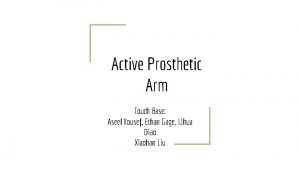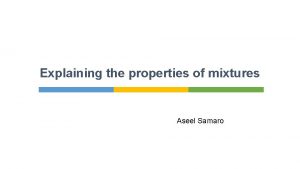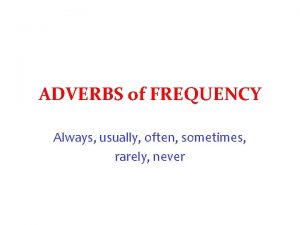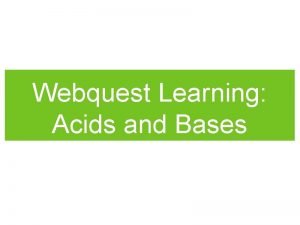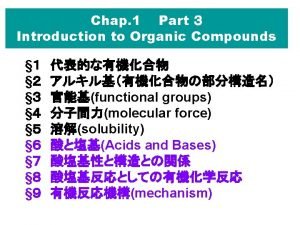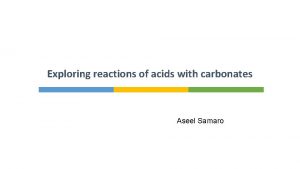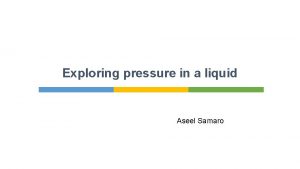Exploring Acids Aseel Samaro Introduction Acids are often



















- Slides: 19

Exploring Acids Aseel Samaro



Introduction § Acids are often thought of as dangerous substances. § Indeed, many acids are dangerous and we must take precautions when handling them. § However, we come across many acids in our daily life that are useful and not dangerous at all.

Useful acids § If you look around your kitchen, you may find some acids to eat or drink. § Citrus fruits such as lemons and oranges contain citric acid. § Vinegar, which is used to pickle foods or to flavour chips, contains ethanoic acid. § Fizzy drinks contain carbonic acid. § Tea contains tannic acid. Acids also have industrial uses: § Sulfuric acid is used in car batteries and in making fertilisers. § Nitric acid can also be used in making fertilisers and in paints.


List some examples of acids that we have in our homes. Describe two acids that may be used to make fertilisers. Suggest what taste acids have in common.

List some examples of acids that we have in our homes. lemons, oranges, vinegar, fizzy drinks, tea etc. Describe two acids that may be used to make fertilisers. sulfuric acid and nitric acid Suggest what taste acids have in common. sour

Considering Hazards § Concentrated acids, such as concentrated sulfuric acid, are extremely dangerous. § These acids are corrosive – this means that the acid can destroy skin and attack metals if spilled. § The types of acid that are often used in science lessons are dilute acids – this means that they have had water added to them. § Dilute acids are not as dangerous as concentrated acids. § They are not corrosive but may be an irritant to the skin. § Your skin might become red and blistered if some acid was spilled on it.

§ Acids that are found in food and drink, such as in lemons and vinegar, are extremely weak and dilute. § This is why they are safe to eat and drink, whereas dilute hydrochloric acid is not. § However, they may still sting if they get into a cut.



Explain why is it better to use images on hazard labels, rather than words. Suggest why you usually use dilute acids in school practical experiments, rather than concentrated acids. Describe the precautions that you should take when working with an acid that displays the hazard symbol. Explain why concentrated acids are more dangerous than dilute acids.

Explain why is it better to use images on hazard labels, rather than words. Universal language; the user doesn’t need to be able to read Suggest why you usually use dilute acids in school practical experiments, rather than concentrated acids. Dilute acids are not as dangerous; irritant is not corrosive Describe the precautions that you should take when working with an acid that displays the hazard symbol. Wear gloves; wear eye protection; take care not to spill Explain why concentrated acids are more dangerous than dilute acids. They are corrosive (destroy skin, attack metals)

What do acids have in common § Some acids taste sour. § Some acids are weak enough that we can eat or drink them. § Some acids would burn your skin. However, one thing that all acids have in common is that they contain the element hydrogen. We can show this by looking at the chemical formulas of acids: üHydrochloric acid, HCl – this shows that the acid contains hydrogen and chlorine. üSulfuric acid, H 2 SO 4 – this shows that the acid contains hydrogen, sulfur and oxygen.

The chemical formula for nitric acid is HNO 3. Which elements does nitric acid contain? A sour-tasting substance is found to contain the elements oxygen, sulfur and hydrogen. Suggest whether or not this is an acid and explain your reasoning.

The chemical formula for nitric acid is HNO 3. Which elements does nitric acid contain? hydrogen; nitrogen; oxygen A sour-tasting substance is found to contain the elements oxygen, sulfur and hydrogen. Suggest whether or not this is an acid and explain your reasoning. it is likely to be an acid because it tastes sour and contains hydrogen

Did you know…? § Your stomach contains hydrochloric acid, which helps to digest food and kill bacteria. § You can feel this acid burning your throat slightly when you vomit.

Thank you
 Insidan region jh
Insidan region jh How to identify pure aseel
How to identify pure aseel Aseel yousef
Aseel yousef Lab samaro
Lab samaro What are stomata
What are stomata Lab-samaro
Lab-samaro Samaro property
Samaro property Often always usually
Often always usually Acids and bases webquest
Acids and bases webquest What is an acid in chemistry
What is an acid in chemistry Why did europeans start exploring
Why did europeans start exploring Exploring online planning and task management
Exploring online planning and task management Lesson 1 exploring conic sections
Lesson 1 exploring conic sections What motivates people to explore the unkown
What motivates people to explore the unkown Paradox ip exploring tools
Paradox ip exploring tools Section 11-3 exploring mendelian genetics answer key
Section 11-3 exploring mendelian genetics answer key Python for informatics
Python for informatics Exponential growth and decay algebra 1
Exponential growth and decay algebra 1 Tangent ratio
Tangent ratio Exploring the water cycle capture sheet
Exploring the water cycle capture sheet


